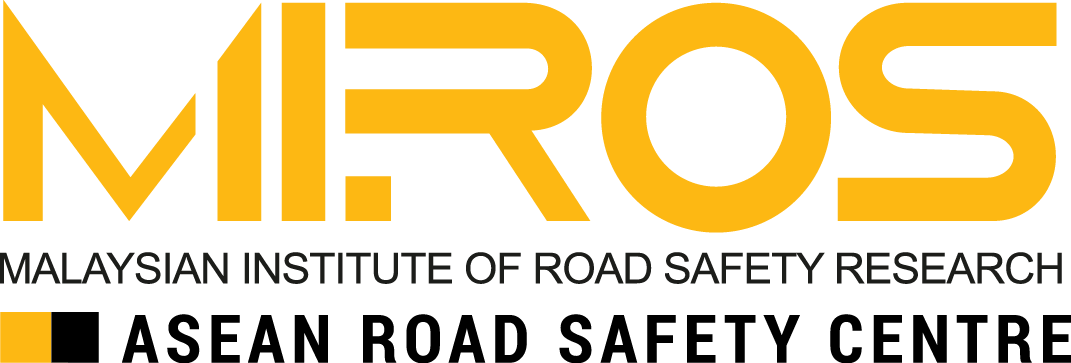Soalan Lazim
Umum
Sebarang surat atau mel surat bagi proses permintaan data perlu melalui Unit Korporat di alamat emel dg@miros.gov.my
MIROS mengumpulkan pelbagai data sekunder dari agensi-agensi yang lain. Antara data yang terdapat di unit ini adalah statistik kemalangan, populasi, bilangan kenderaan berdaftar, panjang jalan dan data-data lain yang berkaitan dengan kemalangan jalan raya.
Sehingga kini, projek penyelidikan yang telah dan sedang dijalankan oleh unit ini termasuklah kesan operasi trafik ke atas kemalangan jalan raya e.g. kajian aliran dan kelajuan trafik, keberkesanan kemudahan untuk motosikal e.g. lorong motosikal jenis eksklusif dan bukan eksklusif, keberkesanan rawatan kos rendah e.g. skim penenangan trafik dan lorekan pembahagi jalan, intervensi persimpangan berlampu isyarat e.g. optimasi lampu isyarat dan belokan ke kiri yang dibenarkan, keselamatan di sekitar kawasan sekolah, serta keselamatan penghadang jalan yang digunakan di lebuh raya.
Unit ini juga menjalankan kerja penilaian keselamatan jalan raya di lokasi-lokasi yang menjadi perhatian orang awam. Unit ini sering menerima permohonan untuk menjalankan penilaian keselamatan jalan raya daripada orang awam, pihak berkuasa tempatan serta ketua komuniti. Hasil penilaian yang didapati akan dimaklumkan kepada pihak-pihak berkenaan untuk tindakan selanjutnya.
Tuan/puan boleh merujuk kepada laman sesawang MIROS untuk mendapatkan maklumat terkini berkenaan kekosongan jawatan.
Tuan/puan boleh merujuk kepada Unit Pengurusan Sumber Manusia.
ITS adalah singkatan kepada sistem pengangkutan pintar dan ianya bermaksud pengaplikasian peralatan baru dan berteknologi tinggi seperti komputer, sensor dan peralatan elektronik didalam bidang pengangkutan dengan objektif untuk menyediakan pengangkutan yang selamat, murah, cepat dan mesra alam. Antara contoh implementasi ITS di negara kita adalah Pengumpulan bayaran tol secara elektronik (ETC), pusat pengurusan trafik (TMC), papan tanda mesej boleh ubah (VMS) dan Terminal Pengangkutan Bersepadu (ITT).
Pada masa ini, unit ITS menjalankan penyelidikan dan pembangunan di bawah 4 sektor utama ITS di Malaysia, iaitu Sistem Pengurusan Trafik, Sistem Keselamatan, Sistem Maklumat Pengembara dan Sistem Operasi Kenderaan Komersil. Antara projek-projek yang telah dirancang dan sedang dijalankan adalah sistem pengumpulan data kemalangan dan analisa, teknologi pemprosesan imej bagi pengiraan trafik, pelaksanaan had laju boleh ubah, perancang perjalanan, sistem pemantauan dalam kenderaan (IVMS) dan pengumpulan maklumat kemalangan dari orang ramai.
SSG ataupun 'Safety Star Grading' adalah program berasaskan pengguna bertujuan untuk memberi petunjuk prestasi keselamatan pengendali bas kepada orang ramai supaya yakin dalam membuat pilihan yang terbaik apabila ingin melakukan perjalanan.
Unit Sains Kecederaan Kemalangan & Pencegahan (CRIS-P), Institut Penyelidikan Keselamatan Jalan Raya Malaysia (MIROS) telah diberi tanggungjawab bagi mengendalikan program ini.
Unit CRASE ditubuhkan adalah untuk menjalankan kajian-kajian yang melibatkan keselamatan kenderaan dengan tujuan untuk memastikan kenderaan selamat digunakan di jalan raya. Focus utama unit CRASE adalah menjalankan kajian berkenaan keselamatan motorsikal, kenderaan berat, keselamatan kanak-kanak dan sebagainya. Selain itu, CRASE juga bertindak untuk menyampaikan maklumat kepada umum berkenaan dengan keselamatan kenderaan. Disamping menjalankan penyelidikan yang berteraskan keselamatan kenderaan, unit CRASE juga mempunyai makmal yang yang mana mampu untuk menjalankan ujian perlanggaran kenderaan. Semenjak tahun 2010, unit CRASE merupakan peneraju utama di dalam menjayakan program ASEAN NCAP.
Keselamatan pasif boleh ditafsirkan sebagai sistem dan peranti yang membantu untuk melindungi penumpang kenderaan daripada kecederaan dalam kemalangan. Fungsi utama ciri-ciri keselamatan pasif ialah memastikan pemandu dan penumpang dilindungi dalam kenderaan dari pelbagai daya kemalangan. Beberapa komponen kenderaan yang diklasifikasikan sebagai peralatan keselamatan pasif seperti tali pinggang keledar, beg udara, penyandar kepala dan zon remuk.
Zon remok membantu untuk menyerap daya hentakan pada bahagian hadapan kenderaan bagi memastikan ruang yang mencukupi untuk penumpang di dalam kemalanagn. Begitu juga , tali pinggang keledar , beg udara , dan penyandar kepala membantu menghadkan pergerakan pemandu dan penumpang dalam zon yang selamat di dalam kenderaan. Ciri-ciri keselamatan seperti ini mengurangkan risiko kecederaan serius dan membolehkan pemandu dan penumpang untuk terselamat dalam kemalangan.
Skop penyelidikan Unit Analisa Tingkahlaku & Penilaian BeHAV meliputi bidang tingkah laku pengguna jalan raya, penguatkuasaan trafik dan juga penilaian kos akibat kemalangan jalan raya.
Unit BeHAV juga menjalankan dua jenis kerja operasi penyelidikan seperti berikut:
Operasi Penyiasatan dan Pengumpulan Data Kemalangan berkaitan Faktor Kemanusiaan (HFRAD)
Bertujuan untuk mengumpul data terperinci dan komprehensif berkenaan dengan faktor-faktor kemanusiaan yg menyumbang kepada kemalangan jalan raya.
Pasukan Operasi Kerja Lapangan (FOT)
Bertujuan untuk menawarkan perkhidmatan perundingan dan kepakaran kerja kepada pusat penyelidikan lain bagi menjalankan kerja pengumpulan data secara survei/pemerhatian/perbincangan secara berkumpulan.
Operasi Penyiasatan dan Pengumpulan Data Kemalangan berkaitan Faktor Kemanusiaan (HFRAD)
Bertujuan untuk mengumpul data terperinci dan komprehensif berkenaan dengan faktor-faktor kemanusiaan yg menyumbang kepada kemalangan jalan raya.
Pasukan Operasi Kerja Lapangan (FOT)
Bertujuan untuk menawarkan perkhidmatan perundingan dan kepakaran kerja kepada pusat penyelidikan lain bagi menjalankan kerja pengumpulan data secara survei/pemerhatian/perbincangan secara berkumpulan.
